Market
Ator Rebrands to Anyone, and More

Decentralized Physical Infrastructure Networks (DePin) are transforming the tech by enabling decentralized projects in real-world infrastructure.
Here’s what happened recently in the DePin sector: leading privacy protocol ATOR rebranded to Anyone, decentralized personal information network Verida raised $5 million, and Layer-1 blockchain Synternet launched its mainnet on the Cosmos network.
ATOR Protocol Rebrands to Anyone
One of 2023’s most successful DePin projects, ATOR, has rebranded as Anyone, marking a switch from the dark web-related browser Tor to mainstream internet privacy. The new name reflects this broader vision: transforming the internet for every user, not just the technically inclined or fringe groups.
The Anyone’s native token is live and actively traded by former ATOR holders. Exchange-based holders will automatically receive the new token after a brief pause.
Originally an incentive protocol for The Onion Router (Tor), ATOR built a strong community focused on running relays for bandwidth rewards. Now, Anyone is creating its own network, leveraging onion routing technology for broader applications. They aim to make privacy the default standard for all internet users and services.
Read more: What Is DePIN (Decentralized Physical Infrastructure Networks)?
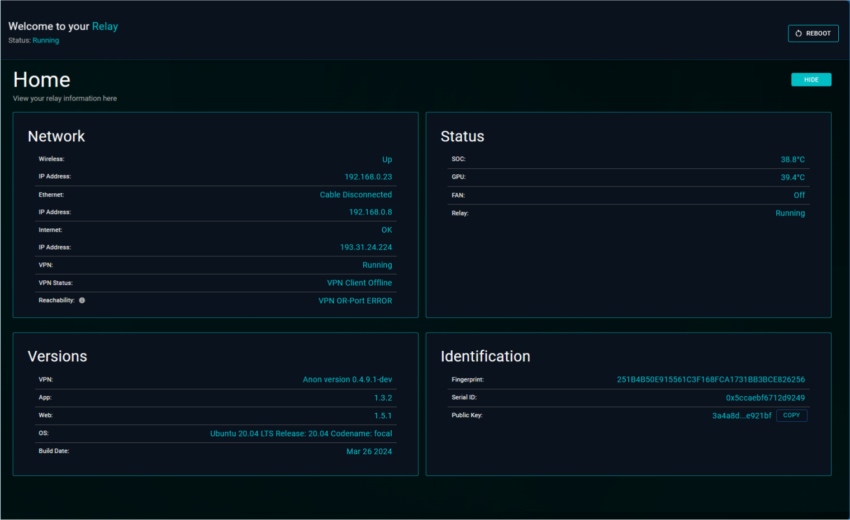
The new DePIN network, Anon, is promoted as a “modular privacy layer for the internet.” Unlike traditional VPNs or browser apps, Anon enables any application to connect to the network either manually or through code. This also allows new apps to be built with privacy as a default setting. Anyone aims to shift privacy responsibility from users to being the standard in every product and service.
Verida Raises $5 Million in Seed and Strategic Funding
Verida, a decentralized data network and self-custody wallet, has raised over $5 million, reaching a valuation of $50 million. Investors in this funding round include O-DE Capital Partners, ChaiTech Ventures, Simurg Labs, and existing investors such as Gate Labs, HASH CIB, Bison Capital, Amesten Capital, and Evan Cheng of Mysten Labs.
Community pre-sales of the Verida Storage Credit token also contributed to the funding. The newly raised funds will help develop Verida’s personal data ownership system. The network plans to offer decentralized storage and encryption for users’ personal information. This means data will be stored across multiple nodes managed by different network participants.
“Verida is poised to disrupt the AI landscape by putting users back in control of their data, unlocking more secure, privacy-preserving personalized AI for everyone,” a Verida representative noted.
Read more: Top Web3 Privacy Challenges & How to Overcome Them
Verida has secured over 20 ecosystem partners, including Polygon ID, NEAR, Partisia, Redbelly, zkPass, Kima, Nillion, and cheqd. This growing network strengthens Verida’s presence within the industry.
Synternet Goes Mainnet on Cosmos
Synternet, the Layer-1 blockchain powering data infrastructure for projects building in the AI, DeFi, DePIN, and IoT space, launched its mainnet on Cosmos. This move supports a new decentralized data economy, allowing developers to create applications using real-time, trustless data streams from all major chains.
The mainnet launch also initiates the token migration from NOIA to SYNT. The full token utility will be unlocked on July 29, when the bridge to Cosmos becomes operational.
“The launch of Synternet’s mainnet on Cosmos is a technical milestone signaling the beginning of a new era for the decentralized data economy. With $SYNT, we’re providing real utility, enabling users to pay for data services at reduced fees and fostering a more inclusive and efficient ecosystem,” stated Jonas Simanavicius, CTO at Synternet.
Read more: Cosmos: A Comprehensive Guide to What It Is and How It Works
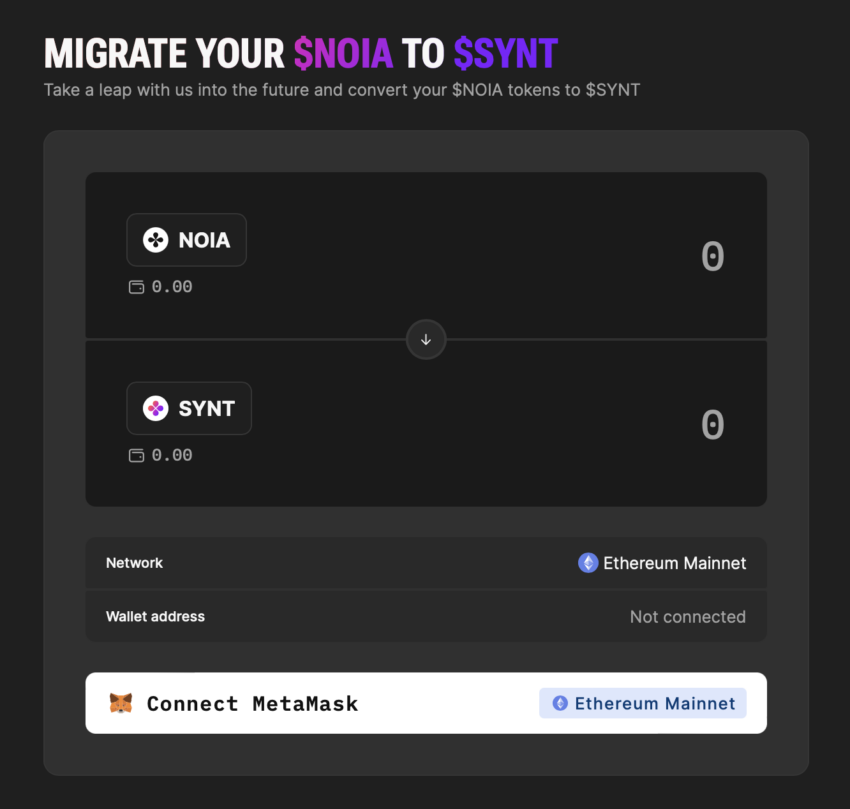
These developments indicate a promising future for DePIN, with more prominent players entering the sector and new solutions emerging. While DePIN is still in its early stages and has some flaws, it allows for the exchange of tokens between synthetic and real-world assets. This supports traditional infrastructure by providing last-mile coverage in areas where conventional models are not economically feasible.
Disclaimer
In adherence to the Trust Project guidelines, BeInCrypto is committed to unbiased, transparent reporting. This news article aims to provide accurate, timely information. However, readers are advised to verify facts independently and consult with a professional before making any decisions based on this content. Please note that our Terms and Conditions, Privacy Policy, and Disclaimers have been updated.
Market
HBAR Futures Traders Lead the Charge as Buying Pressure Grows

Hedera Foundation’s recent move to partner with Zoopto for a late-stage bid to acquire TikTok has sparked renewed investor interest in HBAR, driving a fresh wave of demand for the altcoin.
Market participants have grown increasingly bullish, with a notable uptick in long positions signaling growing confidence in HBAR’s future price performance.
HBAR’s Futures Market Sees Bullish Spike
HBAR’s long/short ratio currently sits at a monthly high of 1.08. Over the past 24 hours, its value has climbed by 17%, reflecting the surge in demand for long positions among derivatives traders.

An asset’s long/short ratio compares the proportion of its long positions (bets on price increases) to short ones (bets on price declines) in the market.
When the long/short ratio is above one like this, more traders are holding long positions than short ones, indicating bullish market sentiment. This suggests that HBAR investors expect the asset’s price to rise, a trend that could drive buying activity and cause HBAR’s price to extend its rally.
Further, the token’s Balance of Power (BoP) confirms this bullish outlook. At press time, this bullish indicator, which measures buying and selling pressure, is above zero at 0.25.
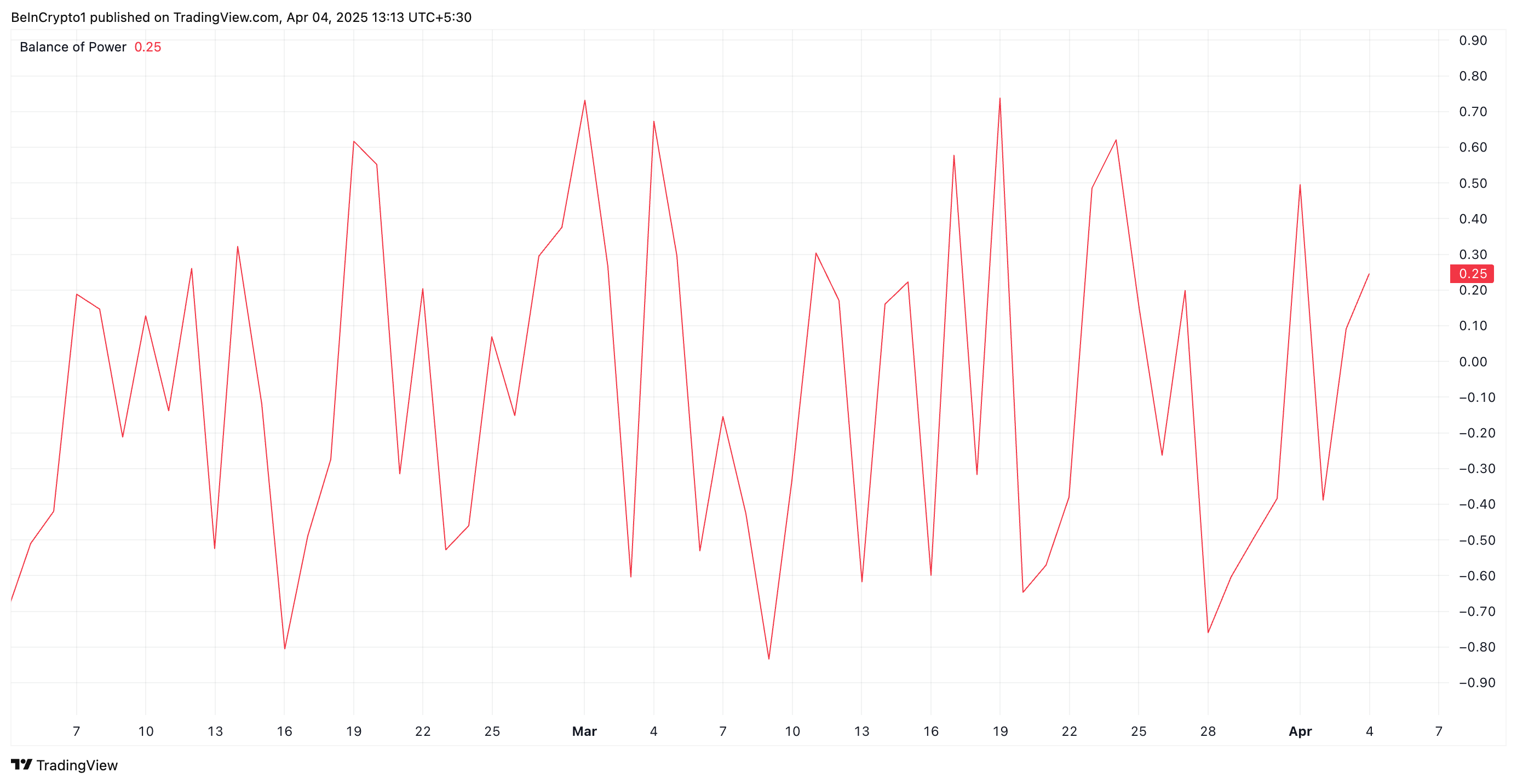
When an asset’s BoP is above zero, buying pressure is stronger than selling pressure, suggesting bullish momentum. This means HBAR buyers dominate price action, and are pushing its value higher.
HBAR Buyers Push Back After Hitting Multi-Month Low
During Thursday’s trading session, HBAR traded briefly at a four-month low of $0.153. However, with strengthening buying pressure, the altcoin appears to be correcting this downward trend.
If HBAR buyers consolidate their control, the token could flip the resistance at $0.169 into a support floor and climb toward $0.247.
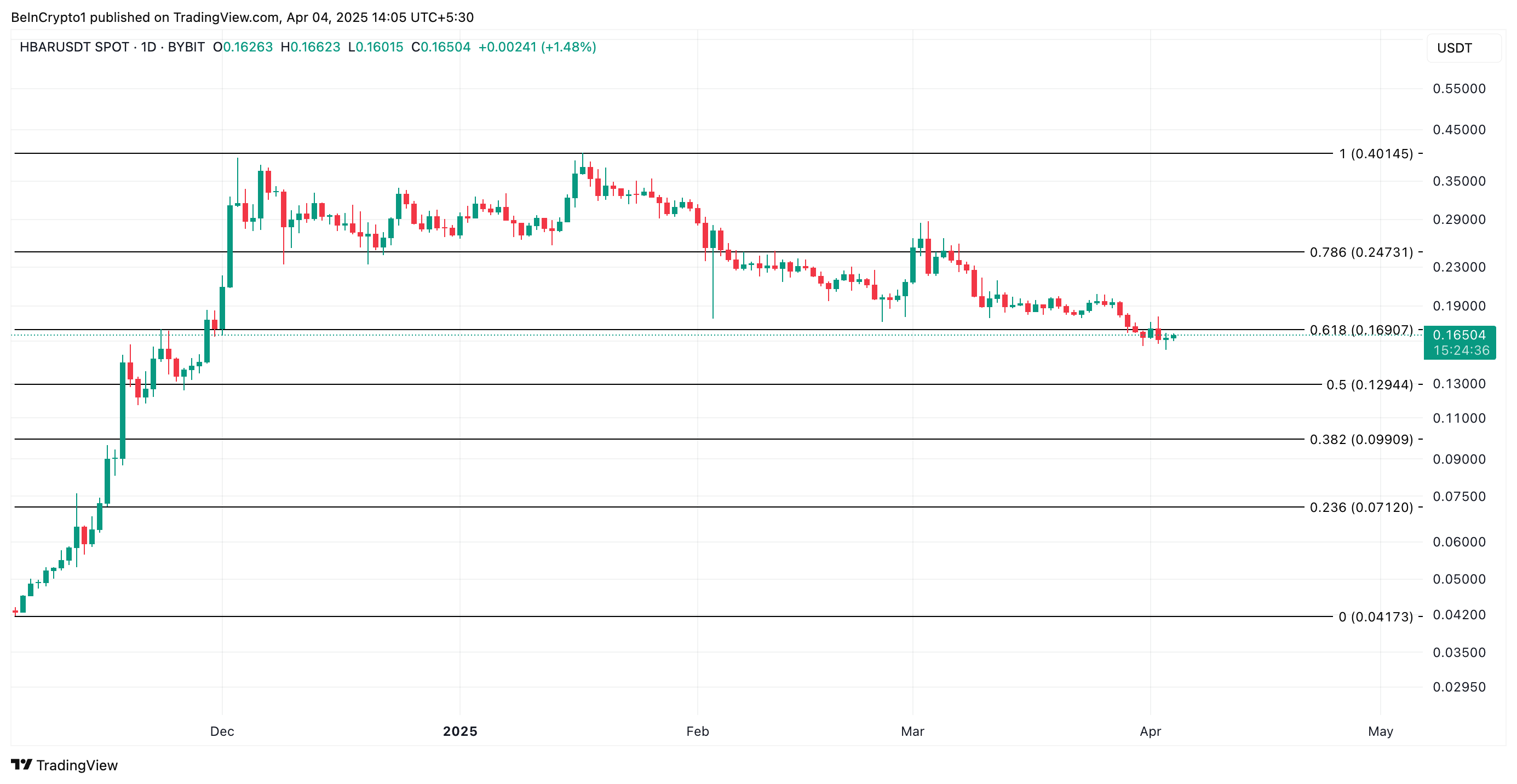
However, a resurgence in profit-taking activity will invalidate this bullish projection. HBAR could resume its decline and fall to $0.129 in that scenario.
Disclaimer
In line with the Trust Project guidelines, this price analysis article is for informational purposes only and should not be considered financial or investment advice. BeInCrypto is committed to accurate, unbiased reporting, but market conditions are subject to change without notice. Always conduct your own research and consult with a professional before making any financial decisions. Please note that our Terms and Conditions, Privacy Policy, and Disclaimers have been updated.
Market
Bitcoin is Far From a Bear Market But not Altcoins, Analysts Claim

Welcome to the US Morning Crypto Briefing—your essential rundown of the most important developments in crypto for the day ahead.
Grab a coffee to see how Bitcoin is holding firm above $79,000 despite a sharp equities sell-off. Markets are bracing for the March NFP report and rising recession risks. With Fed rate cuts on the table and ETF inflows staying strong, all eyes are on what’s next for macro and crypto markets.
Is Bitcoin in a Bear Market?
The highly anticipated March U.S. non-farm payrolls (NFP) report is due later today, and it’s expected to play a key role in shaping market sentiment heading into the weekend.
“With the key macro risk event now behind us, attention turns to tonight’s non-farm payroll report. Investors are bracing for signs of softness in the U.S. labour market. A weaker-than-expected print would bolster the case for further Fed rate cuts this year, as policymakers attempt to cushion a decelerating economy. At the time of writing, markets are pricing in four rate cuts in 2025—0.25 bps each in June, July, September and December,” QCP Capital analysts said.
Traditional markets are increasingly pricing in a recession, with equities retreating sharply—a 7% decline overall, including a 5% drop just yesterday. This broad de-risking environment helps explain the current pause in crypto inflows.
On the derivatives front, QCP adds:
“On the options front, the desk continues to observe elevated volatility in the short term, with more buyers of downside protection. This skew underscores the prevailing mood – uncertain and cautious.”
However, they also note that “with positioning now light and risk assets largely oversold, the stage may be set for a near-term bounce.”
Bitcoin remains resilient despite market volatility, holding above $79,000 with strong ETF inflows and signs of decoupling from stocks and altcoins. According to Nic Puckrin, crypto analyst, investor, and founder of The Coin Bureau: “Bitcoin is nowhere near a bear market at this stage. The future of many altcoins, however, is more questionable.”
Chart of the Day

Chances of a US Recession in 2025 jumped above 50% for the first time, currently at 53%.
Byte-Sized Alpha
– Major ETF issuers are buying Bitcoin, with $220 million in inflows showing strong confidence despite volatility.
– Futures show bullish BTC sentiment, but options traders remain cautious, signaling mixed market outlook.
– Coinbase is launching XRP futures after Illinois lawsuit relief, signaling growing regulatory support for crypto.
– Despite Trump’s tariff-driven crash, analysts see potential for a Bitcoin rebound—though inflation may cap gains.
– The Anti-CBDC bill passed a key House vote, aiming to block Fed-issued digital currencies and protect privacy.
– Today at 11:25 AM, Fed Chair Jerome Powell will deliver a speech on the U.S. economic outlook.
Disclaimer
In line with the Trust Project guidelines, this price analysis article is for informational purposes only and should not be considered financial or investment advice. BeInCrypto is committed to accurate, unbiased reporting, but market conditions are subject to change without notice. Always conduct your own research and consult with a professional before making any financial decisions. Please note that our Terms and Conditions, Privacy Policy, and Disclaimers have been updated.
Market
Cardano Price Recovery Next As Whales Buy 230 Million ADA

Cardano has experienced a tough period, with the failed price recovery and declining market conditions. However, the recent buying behavior of whales and the potential for a price surge suggest a change in momentum.
If Cardano (ADA) can break through the $0.70 level, it could signal the end of the bearish sentiment.
Cardano Whales Are Hopeful
Over the past 72 hours, whales holding between 10 million and 100 million ADA have accumulated over 230 million ADA, valued at over $150 million at current prices. This shift from selling and staying neutral to accumulation indicates a shift in sentiment, with whales optimistic about ADA’s potential for Q2 2025. Their recent activity signals confidence in the altcoin’s recovery despite the recent market struggles.
Whale accumulation is often a bullish indicator as these investors have significant influence over the market. The accumulation is crucial, as it provides the support needed for ADA to break through resistance levels.
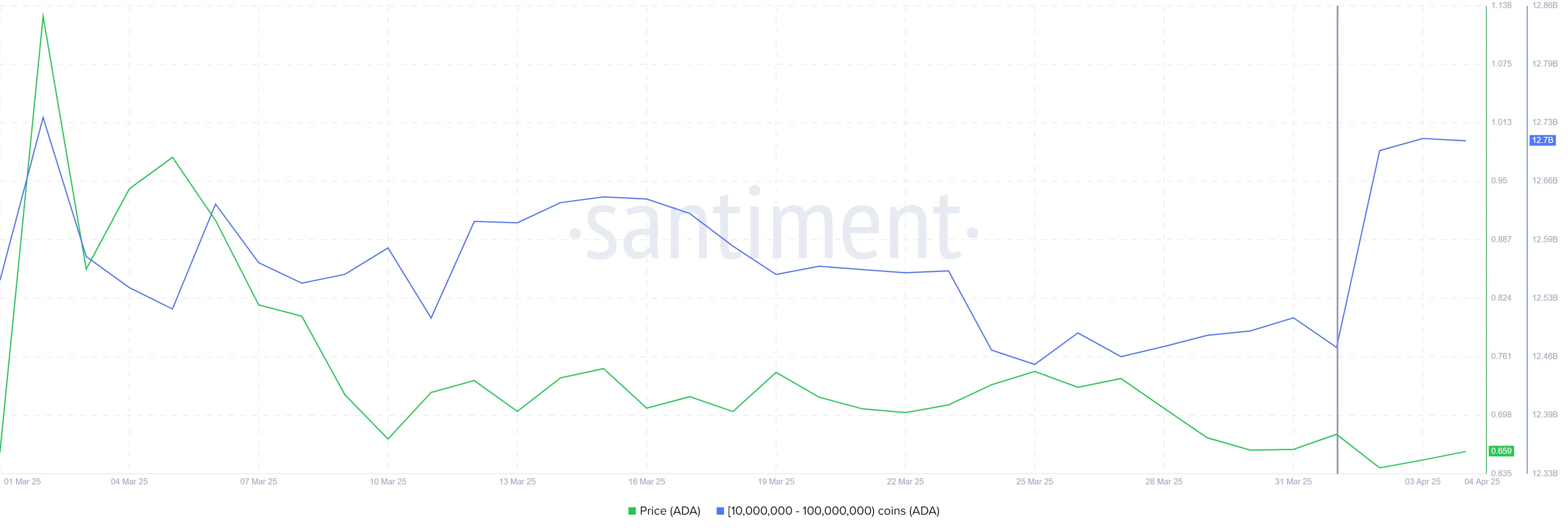
The liquidation map for Cardano shows that approximately $15 million in short contracts will expire as soon as ADA rises above the $0.70 level. This presents a key opportunity for the altcoin. Short-sellers may be forced to close their positions, which could lead to a short squeeze and drive the price higher.
Potential liquidation of short positions may create upward pressure, preventing further declines and allowing ADA to recover. The combination of whale accumulation and the looming liquidation of short contracts could provide Cardano with the momentum it needs to break free from its recent downtrend.

Can ADA Price Breach $0.70?
At the time of writing, Cardano’s price is at $0.65, holding above the crucial $0.62 support level. The altcoin has struggled in recent weeks, but the whale-buying activity offers hope for recovery. A breach of the $0.70 barrier could lead to further upward movement.
Should ADA successfully break through $0.70, it could gain the necessary momentum to continue its recovery. Flipping $0.77 into support would provide an additional boost, positioning Cardano to regain recent losses and possibly challenge higher resistance levels.

However, if Cardano fails to breach $0.70, the price may return to the $0.62 support level. Losing this support would invalidate the bullish outlook and send ADA to a lower level of $0.58, extending the ongoing decline.
Disclaimer
In line with the Trust Project guidelines, this price analysis article is for informational purposes only and should not be considered financial or investment advice. BeInCrypto is committed to accurate, unbiased reporting, but market conditions are subject to change without notice. Always conduct your own research and consult with a professional before making any financial decisions. Please note that our Terms and Conditions, Privacy Policy, and Disclaimers have been updated.
-

 Regulation24 hours ago
Regulation24 hours agoUS Senate Banking Committee Approves Paul Atkins Nomination For SEC Chair Role
-

 Market22 hours ago
Market22 hours agoBinance Managed 94% of All Crypto Airdrops and Staking Rewards
-

 Market23 hours ago
Market23 hours agoPi Network Price Falls To Record New Low Amid Weak Inflows
-

 Regulation21 hours ago
Regulation21 hours agoUS SEC Acknowledges Fidelity’s Filing for Solana ETF
-

 Market19 hours ago
Market19 hours agoWormhole (W) Jumps 10%—But Is a Pullback Coming?
-

 Altcoin19 hours ago
Altcoin19 hours agoAltcoin Season Still In Sight Even As Ethereum Struggles To Gain Upward Momentum
-

 Market21 hours ago
Market21 hours agoXRP Battle Between Bulls And Bears Hinges On $1.97 – What To Expect
-

 Market20 hours ago
Market20 hours agoRipple Shifts $1B in XRP Amid Growing Bearish Pressure


















